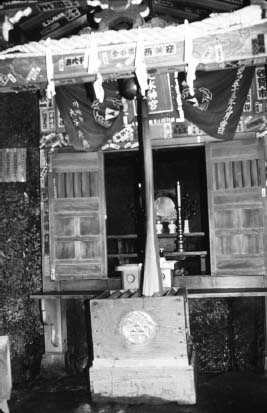ShintoSigns and Symbols |
If visited a Shinto shrine, what would I see? |
Walk down almost any street in almost any Japanese city or town and not many blocks along you will notice a simple, unobtrusive torii gate at street side. Turning to your right to look through the gate, you will be surprised to see a small grove of trees in the midst of storefronts and houses. You know from the torii that a Shinto shrine is nearby, but no structure is immediately evident. You walk through the gate and perhaps up a small hill, and as the shrine comes into view amid the trees you will pass through another torii gate. At the end of the path stands a neighborhood shrine, consisting perhaps of only a single wooden structure. Standing several feet off the ground and too small for a person to enter is the residence of one of the local kami. On the “front porch” of the shrine, or perhaps alongside the tiny steps that lead up to the porch, there are several small white ceramic foxes, messengers of the deity Inari. Also on the porch just outside the shrine door are small offerings of various kinds, including a little wooden box for donations. Uncounted thousands of these unassuming shrines are quiet testimony to the presence of the divine powers.
Larger shrines are naturally fewer in numbers but still abundant. Preserving often relatively extensive tracts of forested land in burgs like Tokyo and Kyoto, the great shrines are all the more remarkable. Even in the heart of bustling Tokyo, for example, the Hie Shrine still sits atop a surprisingly high and densely wooded knoll. As you pass under one and another monumental torii along the pathway to the center of shrines like Tokyo’s splendid Meiji Jingu, you will find yourself slowing down and marveling at the beauty of ancient trees. The sheer power of place here is almost overwhelming, enveloping you with a profound sense of the sacred. At the heart of the place are worshippers, perhaps in large numbers depending on the day, approaching the outer building of the sanctuary to pray and make their offerings. If your timing is right, you might witness formal ceremonies of blessing or priestly offering.
Shinto shrines do not present the kind of public face that Japan’s numerous Buddhist temples show. Shinto’s miniature—and not so miniature—holy forests are vivid reminders of the need to acknowledge the sanctity of nature, especially when the hunger for expediency and immediate gratification compromises reflection.

A small side shrine at Kamakura’s Zeni Arai Benten, dedicated to the one female kami among the seven gods of good fortune, shows the shimenawa above, the five-colored rope attached to the small bell, the offering box, and the symbolic mirror inside the doors that are usually closed in most shrines.
